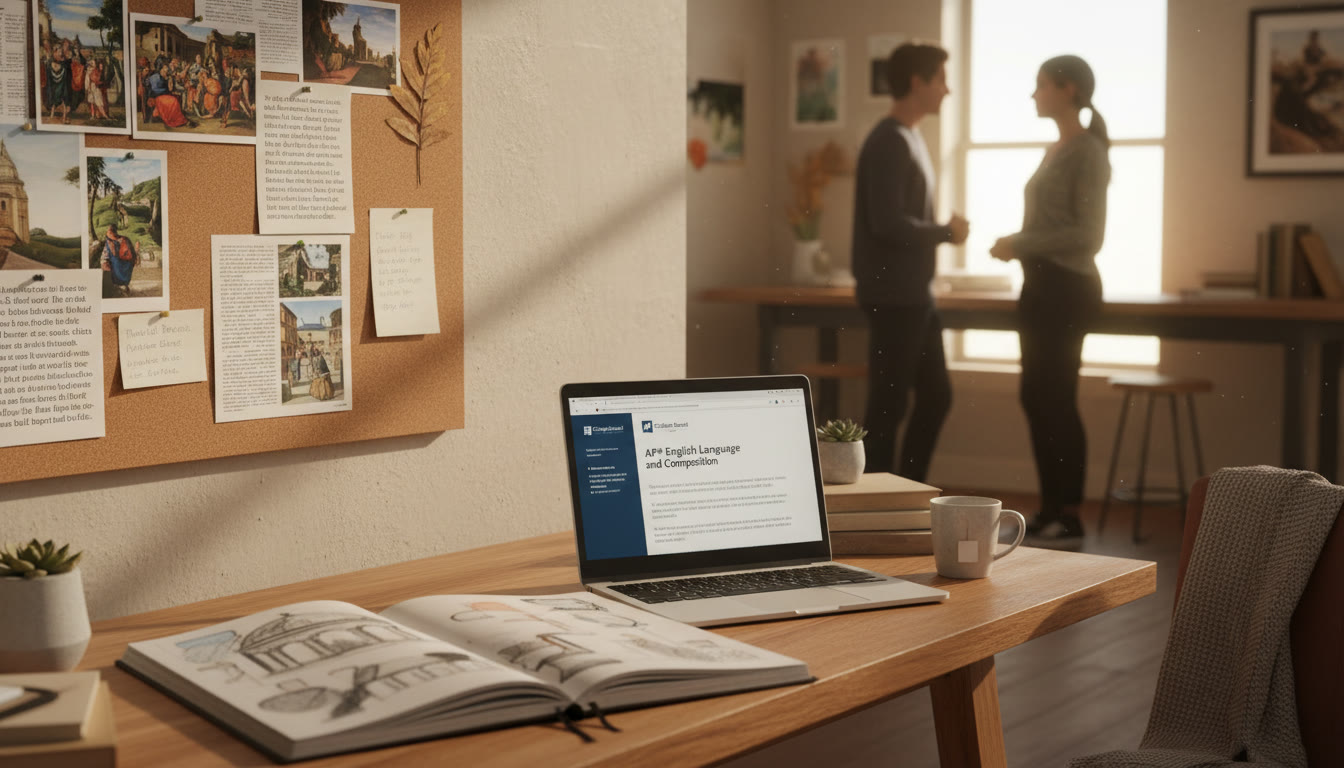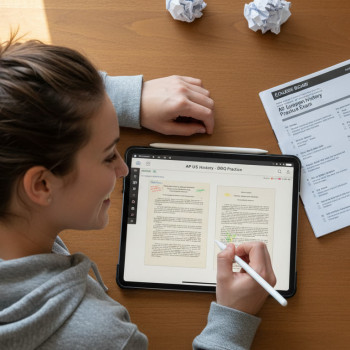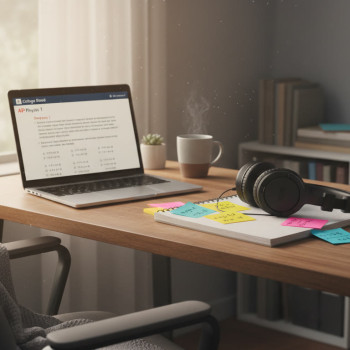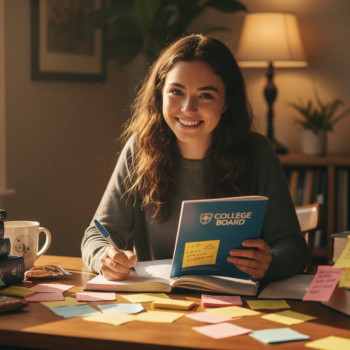Parent Role in Art/Capstone: Support Without Steering
Watching your teenager dive into an AP Art or AP Capstone project is exciting — and a little nerve-wracking. These are not ordinary class assignments. They’re long-form, deeply personal, and sometimes messy processes that ask students to think like artists, researchers, and independent scholars. As a parent, you want to help. But the most valuable help often looks less like direction and more like scaffolding: steady, respectful support that preserves the student’s authorship.
Why Balance Matters: Ownership, Authenticity, and Growth
AP Art and Capstone are designed to measure a student’s capacity for original work. College admissions and evaluators pay attention to authenticity — not polished parental products. When parents over-direct, the student loses the chance to develop critical thinking, creative risk-taking, and resilience. On the other hand, absent or casual support can leave students overwhelmed by logistics, deadlines, and self-doubt. The sweet spot is guided independence.
Practical Principles for Support Without Steering
Here are principles you can apply from day one. Think of them as guardrails — not rules that replace your child’s creative or intellectual choices.
- Ask, don’t tell. Questions foster reflection. Replace instructions with open prompts.
- Prioritize process over product. Celebrate drafts, notes, and research as much as the final piece.
- Set structure, not solutions. Help with planning and logistics rather than design or thesis choices.
- Teach problem-solving skills. Model how to break a big task into pieces, evaluate trade-offs, and revise.
- Normalize iteration and failure. Remind them that revision is evidence of growth, not a problem.
Conversation Starters That Encourage Ownership
Specific language helps. Try these short scripts when you want to be helpful without taking over:
- “Tell me about the idea you’re most excited about. What drew you to it?”
- “What’s something you want to learn from this project — besides the grade?”
- “If you had to explain this to a friend in one sentence, what would you say?”
- “Would you like me to set a timer while you draft, or would you prefer to work independently and check in later?”
- “Do you want help solving this logistics problem, or do you want me to ask questions to help you choose?”
Practical Checklist: What Parents Can (and Should) Do
Many parents feel lost because they don’t know what is useful. Below is a practical checklist that separates supportive tasks from steering behaviors.
| Supportive Actions | Why It Helps | Actions to Avoid |
|---|---|---|
| Help establish a realistic timeline with milestones. | Reduces last-minute panic and clarifies progress. | Rewriting or reorganizing major project elements. |
| Provide materials, workspace, and budget oversight. | Makes experimentation possible without taking creative decisions. | Buying or doing artwork/homework for the student. |
| Offer emotional support: encouragement, breaks, perspective. | Helps students manage stress and maintain motivation. | Telling them exactly how to answer prompts or what themes to choose. |
| Teach practical skills: time-blocking, citation formats, or basic photo documentation. | Builds independence and confidence for future projects. | Editing essays to change voice or major content ideas. |
Weekly Support Rituals
Rituals create predictable touchpoints without micromanaging. Try a 15–20 minute weekly check-in where the student leads the conversation. Use a neutral starter like: “What did you achieve this week? What surprised you? What would you like help with?” This keeps the parent informed and the student accountable while maintaining autonomy.

Helping Without Hijacking: Concrete Examples
Below are realistic scenarios parents often encounter, with recommended responses that support rather than steer.
Scenario 1 — Concept Confusion
Student: “I don’t know if my concept is good enough for the portfolio.”
Parent approaches with anxiety about grades and college admissions.
Supportive approach: Ask clarifying questions: “What excites you about this concept? What problems could it solve or explore?” Offer to help them make a short pros-and-cons list, or to role-play an art critic who asks probing questions. Avoid pitching alternate concepts or insisting on a safer topic.
Scenario 2 — Technical Skill Gap
Student: “I can’t photograph my work well enough to include it in the portfolio.”
> Supportive approach: Teach or find resources on basic documentation — how to use natural light, neutral backgrounds, framing, simple editing for color accuracy. If you have camera equipment or a suitable space, offer it as a resource, but let the student be the one operating and choosing final images.
Scenario 3 — Burnout Near Deadline
Student: “I can’t finish everything.”
> Supportive approach: Help prioritize. Use a triage method: “Which pieces are essential for submission? Which could be simplified without losing concept?” Help them communicate with the teacher if extensions or adjustments are possible. Provide healthy logistical support (meals, quiet time, or a short break) rather than taking tasks off their plate.
Building Skills That Outlast the Project
Parent involvement should teach durable skills: planning, critique, documentation, and reflection. These abilities are more valuable than any single grade.
- Time Management: Help them break the project into weekly sprints with measurable deliverables.
- Critical Feedback: Show how to give feedback that is specific, kind, and actionable. Use the “I notice… I wonder…” framework.
- Documentation: Teach consistent naming conventions, backup routines, and metadata for images and drafts.
- Reflection: Encourage journaling about choices, influences, and changes. This becomes invaluable for artist statements and capstone reflections.
Sample Weekly Sprint Template (Parent-Facilitated)
| Week | Student Goal | Parent Role | Checkpoint |
|---|---|---|---|
| Week 1 | Define concept, create 3 thumbnails or research notes | Help schedule working blocks and supply materials | Review thumbnails; ask clarifying questions |
| Week 3 | Develop first drafts or prototypes | Provide workspace, normal meals, and encourage breaks | 15-minute critique led by student |
| Week 6 | Finalize selected works, document, and start statements | Teach documentation basics; help organize files | Check documentation quality and drafts of statement |
Assessment and Feedback: How to Give Useful Input
Parents often want to help by offering critique. That’s useful when done correctly. Useful feedback is:
- Specific: “The left-hand composition feels crowded” is better than “This doesn’t work.”
- Goal-Oriented: Connect comments to a goal the student chose: “If your goal is emotional intimacy, which parts help that?”
- Question-Based: Ask for explanation: “What do you want the viewer to feel here?”
- Actionable: Suggest a small experiment rather than sweeping changes: “Try cropping this image and see if the focus changes.”
When to Stay Silent
Sometimes the best support is restraint. If you notice a creative choice that you wouldn’t make, pause. Your aesthetic preferences are not the yardstick for originality. Silence reserves the student’s authorship for the student.

Logistics Parents Can Confidently Handle
There are several non-creative but essential tasks where parental help is not only welcome but smart. Handling these responsibly frees the student to focus on the intellectual and creative labor.
- Budget planning for supplies and print costs; prioritize materials that enable iteration.
- Scheduling and transportation for external critiques, portfolio juries, or museum visits.
- Setting up backups (external hard drives, cloud storage) and file-naming systems.
- Helping with the administrative side of Capstone (forms, timelines, advisor meetings) so the student can concentrate on research and writing.
Incorporating External Help: Tutors, Mentors, and Services
Sometimes a student needs more than parental support — a neutral mentor or technical tutor can make a big difference. If you consider external help, choose people who respect student voice and who focus on skill-building rather than producing a final product for the student.
Sparkl’s personalized tutoring and benefits can fit naturally here: their 1-on-1 guidance, tailored study plans, expert tutors, and AI-driven insights often help students refine technical skills and strengthen project planning while preserving student ownership. Use external tutors to complement, not replace, the student’s voice.
What to Look For in a Tutor or Mentor
- Track record with AP-style portfolios or long-form research projects.
- Willingness to work collaboratively with the student’s teacher and to facilitate — not commandeer — work.
- Clear boundaries about what they will and will not do (for example, no writing or creating work for the student).
Preparing for Final Submissions: Polish, Not Parental Polish
As deadlines loom, it’s tempting for parents to step in. Instead, focus on the things that preserve authenticity while boosting clarity.
- Proofread statements for grammar only; don’t rewrite to change tone.
- Check that all required components, images, and metadata are present and formatted correctly.
- Help with practical tasks: scanning, naming files, and uploading. Let the student click submit.
Final Checklist Before Submission
| Item | Student Responsible | Parent Assistance |
|---|---|---|
| Artist Statement or Capstone Reflection | Write and revise | Proofread for typos and clarity only |
| High-quality images or documentation | Capture and select final images | Provide camera/space or help with basic lighting; teach how to scan |
| File naming and backups | Decide naming conventions | Set up backup system and confirm uploads |
When Things Go Wrong: Reassurance That Matters
Projects derail. Photos get corrupted, inspiration fades, or life events intervene. Parents’ reactions in these moments matter more than the mishap itself.
- Normalize setbacks: remind them that revisions and interruptions are part of real creative and research work.
- Prioritize health: a rested and calm student produces better work than an exhausted one chasing a last-minute miracle.
- Help them communicate with teachers early. Most instructors appreciate timely updates and can offer extensions or alternative assessments when appropriate.
After Submission: Reflection and Next Steps
Once the portfolio or Capstone is submitted, resist the urge to analyze every detail. Instead, reflect on lessons learned. What skills did the student develop? Which decisions do they feel proud of? What would they try differently next time?
This reflection is golden for college interviews, essays, and future creative work. Encourage your student to archive the process: drafts, critiques, annotated images, and reflective notes — these artifacts show growth and make future projects faster and richer.
Celebrating Completion Without Overemphasizing Outcome
A submission deserves acknowledgment. Celebrate the commitment, the late nights, and the learning — separate from scores or external judgment. This helps young creatives internalize the value of effort and process beyond grades.
Final Thoughts: Parenting as a Quiet, Confident Presence
Supporting an AP Art or Capstone student is an exercise in trust. The most effective parents are those who show up with tools, time, and tenderness — and then step back. Your role is to protect the conditions that allow authorship to breathe: predictable routines, financial and logistical support, emotional steadiness, and gentle accountability.
When you help your teen learn how to plan, document, argue for their choices, and manage setbacks, you’re giving them a set of professional skills that extend far beyond any AP score. Those are the wins that last.
And if you ever want structured outside support that still preserves student agency, consider services that combine experienced tutors with personalized plans — for example, Sparkl’s personalized tutoring and benefits—1-on-1 guidance, expert tutors, and AI-informed feedback often help students refine their approach while ensuring the final work remains authentically theirs.
Quick Resource List for Parents (What to Keep Nearby)
- Blank sketchbooks and inexpensive material samples for rapid prototyping
- Basic camera or smartphone tripod and neutral backdrop for documentation
- A shared family calendar to block work sessions and checkpoints
- Notebook for reflective prompts: “What did I try? What surprised me? What will I change?”
At the heart of it, helping without steering is about communication, boundaries, and trust. Follow your student’s lead, offer steady scaffolding, and celebrate their ownership. Those choices cultivate not only better projects, but resilient, curious learners ready for the next creative challenge.
Good luck — and remember: the most meaningful support is often the quiet kind that hands over the tools and the time, then watches with pride as the student creates.























No Comments
Leave a comment Cancel